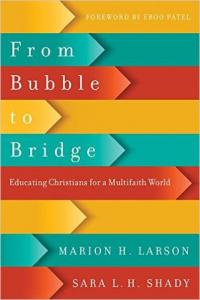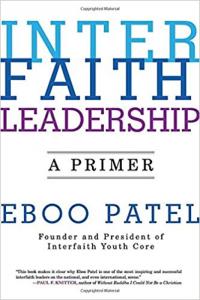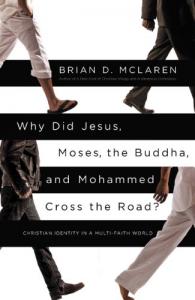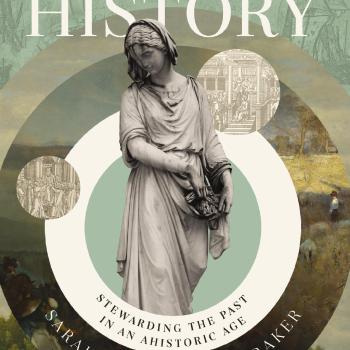Today I’m pleased to welcome to The Anxious Bench two of my Bethel University colleagues: Marion Larson (professor of English) and Sara Shady (professor of philosophy).
 During the last several years, we’ve been involved in interfaith engagement with students from Bethel University, around the Twin Cities, and beyond. This work has grown out of a strong belief that we have a responsibility to prepare college students to constructively navigate the religious diversity of the 21st century. Instead of seeing religious diversity as a barrier or danger to the common good, we are inspired by the great opportunities religious diversity has for helping us grow to better understand both ourselves and our neighbors, so that we may work together to address the social challenges that face us.
During the last several years, we’ve been involved in interfaith engagement with students from Bethel University, around the Twin Cities, and beyond. This work has grown out of a strong belief that we have a responsibility to prepare college students to constructively navigate the religious diversity of the 21st century. Instead of seeing religious diversity as a barrier or danger to the common good, we are inspired by the great opportunities religious diversity has for helping us grow to better understand both ourselves and our neighbors, so that we may work together to address the social challenges that face us.
One of the obstacles we’ve faced over the years is trying to convince other Christians, particularly those who identify as evangelical, that it’s appropriate (let alone beneficial) for Christians to participate in interfaith engagement. We’ve come to believe that this work is deeply tied to living out what it means to be a Christian in a multifaith world. So, we’ve developed a growing list of some of the main concerns some Christians have about interfaith engagement and our answers to them. We hope this list inspires you to think about interfaith engagement as a way to show love to your neighbors, even those who believe very differently than you.
Barrier One: Concern over the term “interfaith”
Some Christians avoid dialogues and other engagement activities that are advertised as “interfaith” efforts. They fear that the purpose of these activities is to reduce religious beliefs to a sort of least-common-denominator theology that ignores important distinctions between religions, focusing only on commonality. In discussions that focus only on commonalities, where is there a place for the unique claims of Christ?
It is true that many interfaith dialogues and activities try to build bridges between people by focusing on commonalities such as ethical imperatives present in most religions (e.g., love your neighbor, care for the poor, seek justice, be a good steward of resources). But interfaith engagement doesn’t stop there, particularly once trust has been established and relationships have begun to develop.
Two other terms — “interreligious” and “multifaith” — are sometimes proposed as alternatives:
- Interreligious: This term suggests that interactions occur between religions (Christianity or Islam or Judaism), or perhaps between leaders with the proper credentials to represent a religion (pastor or imam or rabbi). While such interactions are important, we are hoping to promote engagement and relationship-building between individuals who may or may not be religious “professionals.” Thus, we don’t prefer this term.
- Multifaith: This term recognizes that the focus isn’t so much on religions themselves but, instead, is on those whose beliefs and practices connect them to different religions in individual, often personal ways. It also recognizes the variety of ways in which people “orient around religion,” as interfaith leader Eboo Patel says. Thus, this term has much to recommend it and may be useful as a substitute for “interfaith” among some Christians. At the same time, we also like “interfaith” because the prefix “inter” helps to emphasize what can be built between people of different faiths and traditions.
Barrier Two: Concern over the term “pluralism”
A second issue often raised when Christians consider interfaith engagement is concern over whether or not participation requires a commitment to some form of theological pluralism or an affirmation of all religions as valid paths to God. It is true that one of the goals of interfaith work is civic pluralism, but it is important to recognize that this is not synonymous with theological pluralism.
“Diversity is a fact,” says Diana Eck, Professor of Religious Studies and Director of the Pluralism Project at Harvard. But, she continues, “Pluralism is an achievement.” What does she mean by this? Eck makes a helpful distinction between a simple reality (diversity) and the stance that one takes toward this diversity (pluralism). What what does this stance look like? In his recent book, Interfaith Leadership: A Primer, Eboo Patel describes a pluralistic stance as “proactive engagement of diversity toward positive ends.” He develops this definition further by describing three components of pluralism:
 Cultivating respect for different religious identities. This doesn’t have to mean agreeing with another person’s beliefs, however. But it does mean respecting the dignity and value of another human being, including her identity as a religious person seeking to understand and worship God. And it means supporting each person’s right, in a diverse democracy, to freedom of religion.
Cultivating respect for different religious identities. This doesn’t have to mean agreeing with another person’s beliefs, however. But it does mean respecting the dignity and value of another human being, including her identity as a religious person seeking to understand and worship God. And it means supporting each person’s right, in a diverse democracy, to freedom of religion.- Cultivating positive relationships between diverse religious communities. Once again, this doesn’t have to mean agreeing with the beliefs and/or practices of a different religious community. But it does mean supporting that community’s right to religious freedom, which might include, for example, advocating on behalf of a local Islamic community’s right to build a mosque. And it means seeking to get to know our religious neighbors, seeking to support each other in our efforts to be forces for good in our society.
- Being committed to the common good.
Notice that the term “pluralism” in Patel’s definition is primarily about our civic actions and attitudes. As a Christian who recognizes the uniqueness of Christ, I might not consider myself a theological pluralist, but I certainly should seek to pursue and cultivate civic pluralism, working with people from various faith traditions (and from those of no faith) to relate to each other as fellow citizens of our common nation.
Barrier Three: Conflicted Religious Identity Syndrome
Another common concern expressed by Christians is that interfaith engagement will weaken one’s commitment to Christianity. If we are learning about other religions, and befriending people who are deeply committed to a completely different view of truth, aren’t we in danger of being “led astray”? Shouldn’t a committed Christian be wary of ongoing relationships with people from other religions? When interacting with non-Christians we don’t want to come across as judgmental, but we also want to ensure that we aren’t compromising our own faith commitments.
 Brian McLaren describes this concern as “Conflicted Religious Identity Syndrome” in his book Why Did Jesus, Moses, the Buddha, and Mohammed Cross the Road? Describing this tension in Christian identity, McLaren asks:
Brian McLaren describes this concern as “Conflicted Religious Identity Syndrome” in his book Why Did Jesus, Moses, the Buddha, and Mohammed Cross the Road? Describing this tension in Christian identity, McLaren asks:
How do we remain loyal to what is good and real in our faith without giving tacit support to what is wrong and dangerous? How do we, as Christians, faithfully affirm the uniqueness and universality of Christ without turning that belief into an insult or a weapon?
Thankfully, loving our religious neighbors doesn’t require abandoning our own faith commitments. Rather it flows directly from Jesus’ statement that the two greatest commandments are to love God and to love neighbor. In loving our neighbors well, including those of other faith traditions, we actually affirm what we believe is right and good about Christianity.
Barrier Four: The Great Commission
Isn’t love of neighbor, however, best expressed in terms of a concern to save my neighbor’s soul? A fourth reason Christians may be reluctant to participate in interfaith work is the concern that the main job of a disciple of Christ is to convert the lost by sharing one’s faith. Interfaith engagement events typically ask all participants to refrain from proselytizing. This is done out of respect for all participants and to try to prevent offense or discrimination. Some Christians, however, are afraid that this limits their ability to live out what they believe to be one of the most important aspects of the Christian life: evangelism.
First, it is important to note that although participants in interfaith events are typically asked to refrain from proselytizing, they are never asked to refrain from talking about their religious identity. In fact, sharing important texts and teachings from one’s own religion — and explaining how they shape one’s identity and life choices — is an essential part of interfaith work. Christians will find they have more opportunity to talk about their faith at interfaith events than at many other civic events. For example, we’ve participated in events where we’ve discussed what our religion has to say about service, prayer, gun violence, racism, and suffering, to name just a few topics.
It is also important to remember, however, that there are many ways to share one’s faith besides using words. We live out the command to love our neighbors when we fight religious prejudice, really listen to another’s story, abandon fear and begin to get to know others who are different from us, and stay committed to ongoing relationships with people regardless of whether or not they come to share our beliefs. In loving our neighbors well, we affirm their humanity as God’s creation, which may be the most powerful way to share the love of God with another person.
Barrier Five: Competing Priorities
As Christians living in the 21st century, there are numerous local and global issues competing for our attention. And, often we’re trying to make up for the failures of past generations, trying to right historical wrongs with urgency. This leads some Christians to suggest that they don’t have time to worry about interfaith work, because other issues seem more pressing and relevant. One of the issues often referenced in this context is racial reconciliation. “There’s no time to focus on building bridges to religious ‘others’ when we still have so much work to do finding unity within the body of Christ.” “The church has been segregated for far too long, we need to pour our identity and resources into making Christian community open to everyone, regardless of race or ethnicity.”
It is crucial that we learn to address and correct Christianity’s history of racism and segregation. But working on this issue doesn’t prevent us from simultaneously working to address religious discrimination as well. In fact, helping Christians learn to recognize privilege and work for reconciliation are transferrable skills. When we come to realize the unearned benefits we reap from being white in American society, we can more easily also begin to recognize the advantages we have by living in an overwhelmingly Christian society. And vice versa. When we learn to be allies for those who are marginalized, whether for reasons of race, class, gender, or religion, we learn to welcome, listen to, and support strangers among us. It’s important that we remember that Jesus could often be found at the margins of society, among the poor, among the women, and among religious others: the Samaritans! He did not prioritize one group of needy above another. Rather, he taught us to love all of our neighbors.
For further elaboration on these and other related topics, as well as an extensive list of resources for encouraging Christian participation in interfaith engagement, see our recent book: From Bubble to Bridge: Educating Christians for a Multifaith World (InterVarsity Press, 2017).













